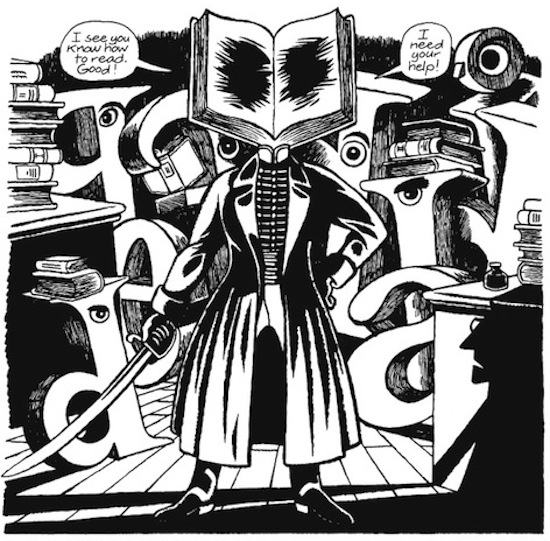Welcome to the first Quietus Comics Column of the new year! Hope you’re all having an excellent 2015. Thanks very much for all your kind comments on my 40 Years of Humanoids piece and interview with Kieron Gillen & Jamie McKelvie. It was tough fitting forty years of such a fine company into a manageable piece, I’m glad it came out alright. And hope you’re continuing to enjoy The Wicked + The Divine.
A large box arrived in the post around the end of November. I wasn’t expecting anything but Drawn & Quarterly had sent me Shigeru Mizuki’s Showa: A History Of Japan 1944 – 1953 (review below). Aside from being a very good read, introducing me to lots I didn’t know about the country, the book is presented in the ‘traditional Japanese manner’, reading from right to left across the book and across the page. I’m convinced this is the way we’re meant to read – we perceive things first in our right, intuitive, brain before making sense of them in our left, logical, sphere. The ancient languages are written in this way. As it is now my goal is to be able to draw the comic scripts I have in mind, I’ve been reading Dr. Betty Edwards’ excellent Drawing On The Right Side Of The Brain, which offers much insight into the workings of the two sides of the brain and how we can use this to become better artists. This of course involves perceiving the world in a different way. It was Mikey Georgeson who got me thinking more about this stuff. He had the Foundation for Brain Integration going for a while on Facebook. It’d be nice if that started up again. Mikey’s recommended Iain McGilchrist’s The Master And His Emissary a few times, which looks fascinating – “the division of the brain into two hemispheres is essential to human existence, making possible incompatible versions of the world, with quite different priorities and values.”
But on to the comics! If anyone’s at Angoulême next week, give a shout.
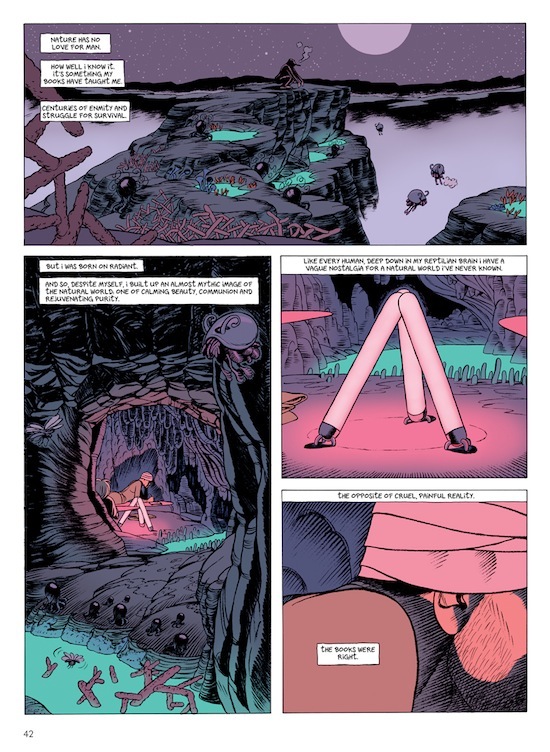
Frederik Peeters – aama 2. The Invisible Throng
(pub. SelfMadeHero)
Stop what you’re doing right now and buy this book. It is BEAUTIFUL. In our Quietus interview last year, Peeters told us ‘for me science fiction is like a journey which is also mixed with visions and dreams’. The journey here is spectacular, and Peeters is on par with Moebius (a big influence) in depicting the ‘inner landscapes of characters’. Internal life is vividly reflected outward in the psychedelic ultrabloom of accelerated Mother Nature on planet Ona(ji), as well as through the sleek urban neon and space age city bustle on home sphere Radiant. Picking up where Volume 1, ‘The Smell of Warm Dust’, left off, Verloc is still caught up in his brother’s trek to Ona(ji) to find out what happened to the scientific expedition left stranded there. Having located most of the team, Verloc and co., led by cigar-smoking robot Churchill, are now out searching for the leaders who have wandered off from the exiled community. Each individual we come across has their own obscured agenda and one of the main themes of the book is that of the nuanced complexities of relationships. Technology, its uses and abuses, and our belief in it, is the other prominent subject. Particularly in how technology affects human ties. On this distant planet where an experiment is mutating out of control, Verloc recounts his uneasy past with his ex-lover and their mute daughter, who he is now banned from seeing. He tells of the near impossible struggles encountered when deciding to have a human baby in a society that is turning its back on such ideas in favour of ‘progress’. The art is sensual and captivating, a sense of warm depth and near mystic enchantment. Much like how Peeters’ Pachyderme sways between green and purple, here too the colour palette opens out through myriad shades of sunhazy yellows, fogsoaked blues, and beyond, evoking the dazzle and charm of light. – Aug Stone
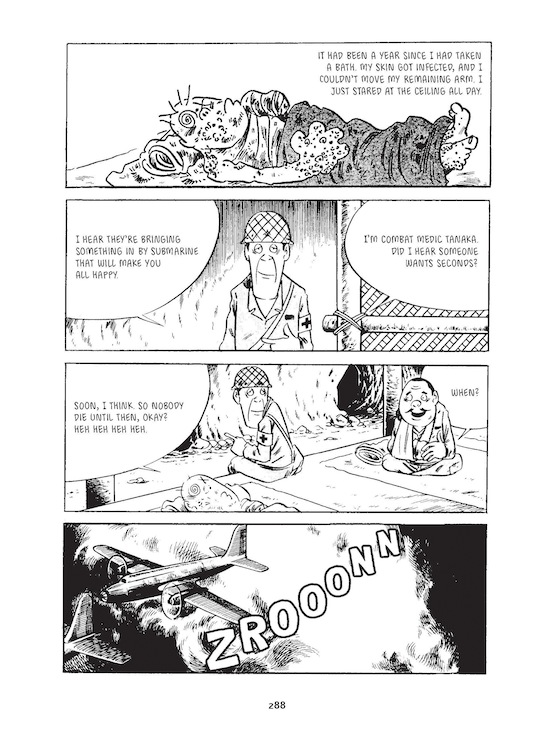
Shigeru Mizuki – Showa: A History Of Japan 1944 – 1953
(pub. Drawn & Quarterly)
Shigeru Mizuki continues his history of the Showa period of Japan in this sprawling 500+ page work. The scope is vast, as both Mizuki’s personal saga and Japan’s role in the world at large are shredded through the tail end of the devastating war to its difficult-to-say-the-least rebuilding in the post-war years. He offers firsthand accounts of what life was like in his country – degrees of wreckage that most foreigners might not be aware of, daily life made all the more grim by bad decisions leaders made in the name of honour. Rampant starvation, homelessness, poverty. He recounts these through his alterego of Rat Man, a loveable character who pops his head in and provides us with the details. Mizuki’s own struggles include wandering for days without eating or sleeping whilst avoiding being captured by the enemy, finally contracting malaria and eventually losing an arm. This, however, didn’t stop him from helping to found manga and becoming one of Japan’s most respected artists. He also touches on the interesting Japanese belief in supernatural beings (yokai), whose seeming intervention at a time of supernatural exhaustion saved Mizuki’s life. The twists and turns his post-war life lead him down, whilst challenging, are not without amusing incidents such as his being asked to join a secret society who haven’t decided what they are even about yet. And though the husk of that society was shed quite early on, it was an essential element in his finding work and eventually getting to art school. – Aug Stone
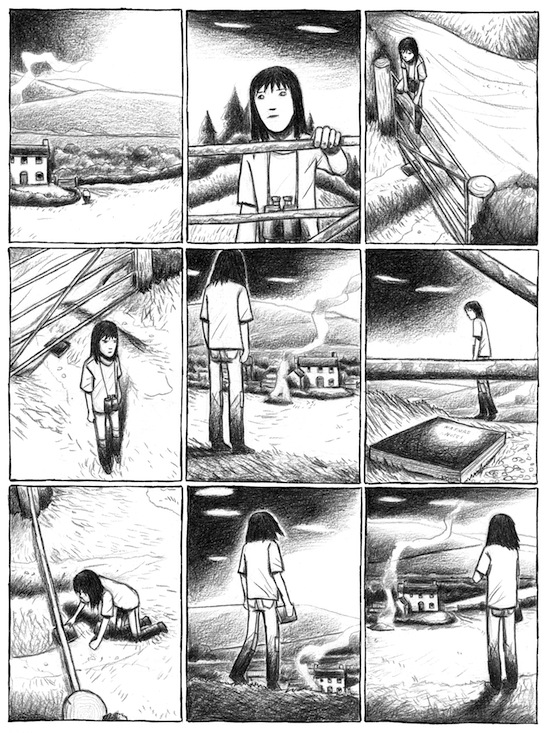
Carol Swain – Gast
(pub. Fantagraphics)
At pace with its setting, Gast slowly draws one in until, like the rural hills of the Welsh countryside Carol Swain sketches, one is quite struck by the simple wonder surrounding. The story unfolds through slight misinterpretations, and recently relocated young Helen feels a growing connection to the local ‘rare bird’ who has taken its own life. She spends her days exploring and sketching her findings, making friends with two canines – who ask are you ‘Gast or Ci?’ (Bitch or Dog) – and a stoical ram. Her investigations send her back over the border to England evoking those slightly confounding but delicious youthful tastes of freedom. All the while keeping a journal much like the book Gast itself. These are fine pencil sketches doing much to set the mood, and Gast is about mood as much as anything else. Describing the flow of the story would surely give it away so I recommend you wade in for yourself. – Aug Stone
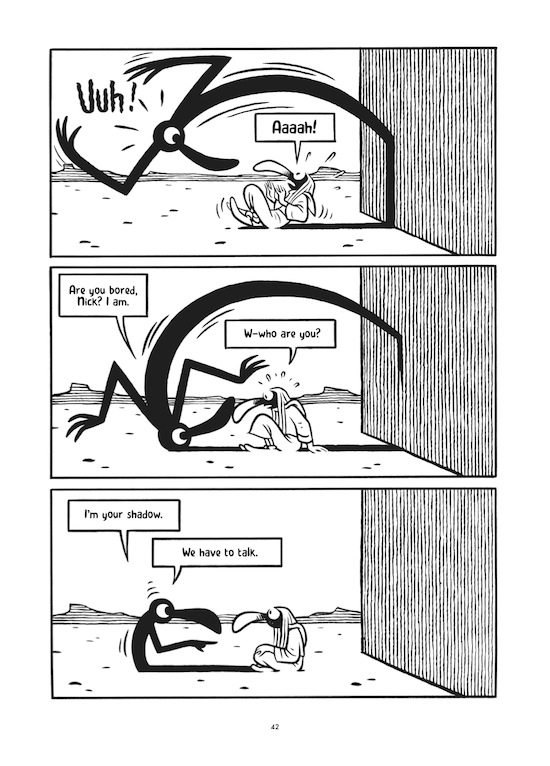
Max – Vapor
(pub. Fantagraphics)
Vaguely defining a spiritual quest for himself, Nicodemos is now out lying on his back in the desert in an attempt to find meaning. A really enjoyable book that examines our desire for such things and all the complications that arise thereof. Told in simple yet stylish black ink, Nick’s process of detachment from the earthly realm is anything but simple. Enter Mosh, a ‘crass cat’, who can hook him up with anything his physical form requires. And Juanita, a thieving bird, who does just that whilst offering insight into being comfortable with our own natures. The highlight of the book is Nick’s extended altercation with his shadow, a cool-looking scene as well, going into the mystical interpretations of that dark projection of ourselves and leading into a bizarre otherworldly sequence. (On a side note, in Jodorowsky’s The Spiritual Journey of Alejandro Jodorowsky there’s a fascinating bit where Doña Magdelena, during the 40 days of her reworking Alejandro’s entire body, washes his shadow with lavender-scented water and soap.) But the book is not without a great deal of fun mixed in too. Madonna’s ‘La Isla Bonita’ is one of Nick’s main ties to his old life, he quotes Dinosaur Jr.’s ‘Feel The Pain’, and an Oscar The Grouch figure offers much spiritual wisdom. Nick faces a good amount of regressions and anger at his lack of progress as many momentary metamorphoses are exposed are delusions. All leading him to the transcendence of Vapor. But what is Vapor? – Aug Stone
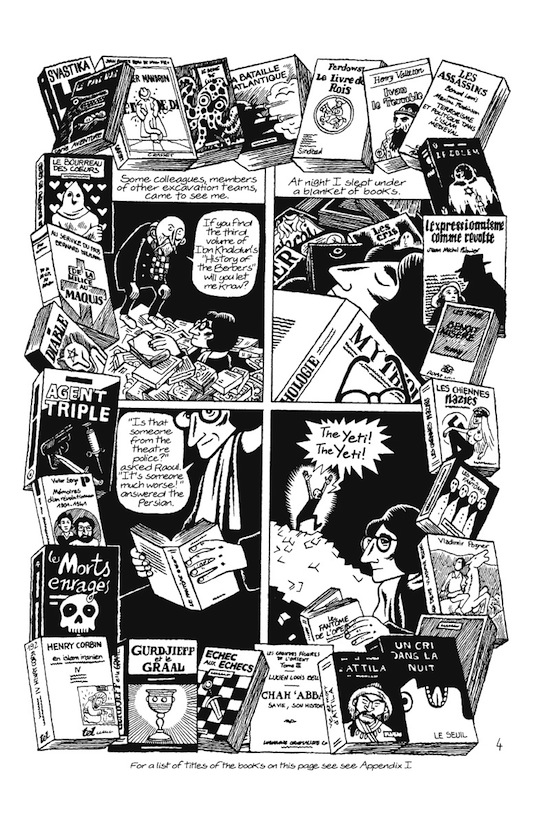
David B – Incidents In The Night 1
(pub. Uncivilized Books)
David B’s awesome imagination and unique style meet once again in this occult literary adventure. As ever, the French cartoonist excels at portraying the mysterious and intriguing that lurks under the visibility of life on the surface (‘occult’ after all simply means ‘hidden’). Out perusing the bookshops of Paris in a dream, Mr. B comes across two old volumes of ‘Incidents In The Night’, ‘a collection of fantastic stories based on news snippets from the 19th and 20th centuries’. But dreams and reality cross paths, and while continuing his search in the light of day, wading through literally mountains of books, a marvelous metaphysical game begins. The more he discovers about the editor of those collections, one Émile Travers – a ‘fanatical Bonapartist’, the more he’s dragged into Travers’ seemingly immortal realm, one which exists in books themselves. And one where the Angel of Death is quite active and where David B himself begins to learn more about an ‘unknown god’ and the history of genocide. B’s evocations of everything – book covers and bookshops, the streets of Paris, Babylonian myth, and much else – are wonderful to behold. His myriad, connective uses of the letter ‘N’ do much to satisfy the mind and the story itself is a testament to all stories have to offer. Expect Volume 2 later this year. I, for one, cannot wait. – Aug Stone
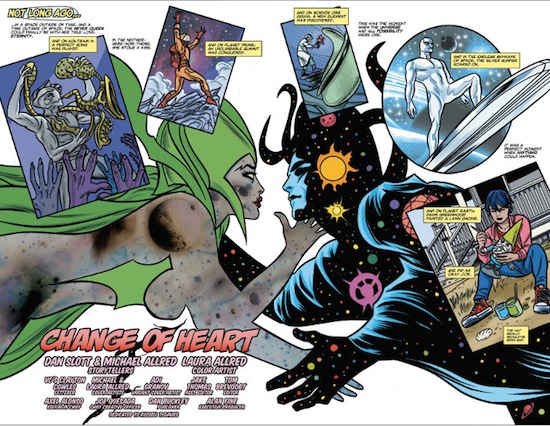
Dan Slott (words), Mike and Laura Allred (art) – Silver Surfer
(pub. Marvel)
Despite being one of Marvel’s most iconic characters and a personal favourite of the company’s very own P.T. Barnum, Stan Lee, the Silver Surfer has enjoyed a somewhat peripatetic existence, littered with limited mini-series and cancelled books that failed to find an audience. Whether writer Dan Slott’s current take on the character, now up to issue 8, can reverse that trend remains to be seen but while it lasts Slott is treating us to one of the best monthly comics the ‘big 2’ are producing today. Steeped in messianic metaphor, the alien Surfer has often been presented as an aloof, unknowable, and all-powerful character, interesting for sure but hard to truly care about. With this in mind Slott takes a page from the Doctor Who playbook and has lumbered our ‘Sentinel of the Spaceways’ with a human companion, b&b manager Dawn Greenwood, to act as a down to earth foil to his more highfalutin’ extra-terrestrial ways. Meanwhile Slott distances the comic from much of the current Marvel universe and instead takes his cues from the Surfer’s ‘Silver Age’ origins, dropping our unlikely duo onto impossible planets, pitting them against giant wind-up monkeys, embroiling them in the courtship of godlike entities, and generally letting his fertile imagination run riot.
The results are simply a blast and an unmitigated joy from cover to cover. Still, for all its wild flights of fancy, genuinely funny jokes, and the amiable parodies of the kind of overblown declamations Marvel’s cosmic characters are prone to employ, Slott is, at heart, telling a love story of sorts. It’s well worked stuff that sneaks up on you. But as we bear witness to the mismatched pair’s burgeoning relationship, you find yourself investing more and more in these comic characters’ futures. All of which makes the most recent issue – when the Surfer’s previous life, as a kind of travel-agent-cum-tour-guide for terracidal cosmic hungry hippo Galactus, finally comes back to bite him on his shiny metal arse – all the more impactful.
Of course to really do it justice, a great script needs great art. In this respect the husband and wife, artist and colourist, team of Mike and Laura Allred has spoiled Slott rotten. Big, bright, and bold, the Allred’s style, a riff on ’50s and ’60s cartooning and pop-art, brings the book vibrantly to life. The myriad bizarre alien species and exotic locations are depicted with relish in powerful lines and eye-popping hues and every issue is filled with panels that genuinely fill you with childlike wonder. Whilst Marvel’s main titles, centred on Jonathan Hickman’s Avengers, rumble on towards the conclusion of one of the most long running and convoluted epics in its history, Slott and the Allreds provide a much needed gentle respite. This Silver Surfer is an undisguised love letter to the medium, one for all ages, sexes, and comic book fans whether they know their 75 years of Marvel continuity inside out or visibly shudder at the thought of grossly inflated balloon men punching each other through mountains. It’s fairly clear that everyone involved in this book is having the time of their lives and that enthusiasm is virulently infectious, long may it continue.
‘A New Dawn’ collecting issues 1-5 is out now, issue 8 has just been published. – John Power
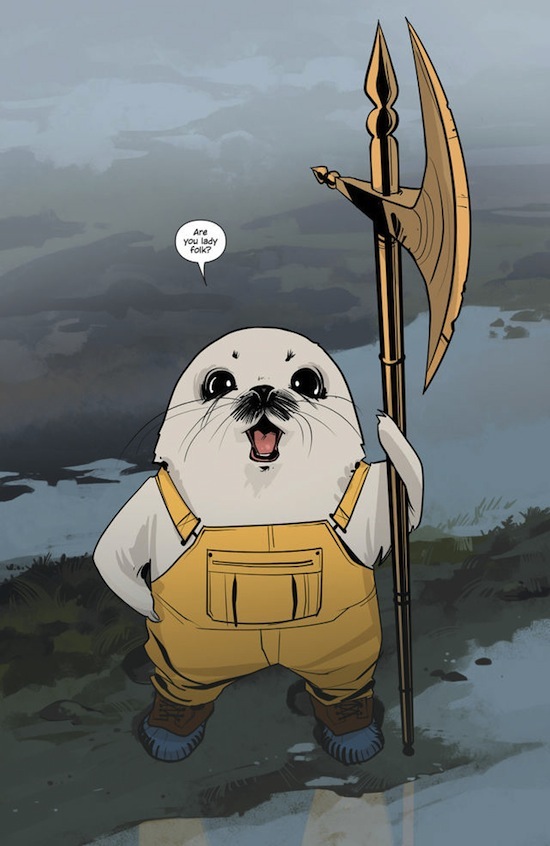
Brian K. Vaughan (words) and Fiona Staples (art) – Saga
(pub. Image Comics)
With the recent publication of Volume 4 and bundling together of the first three into one deluxe book, now is as good a time as any to jump onto writer Brian K. Vaughan and artist Fiona Staples hugely acclaimed sci-fi/fantasy space opera Saga. Set against the backdrop of a galaxy wide war, Saga focuses on a pair of star-crossed lovers, rival soldiers Marko and Alana, and their attempt to raise a child when it seems the whole universe wants them dead. From its outset, Vaughan made clear the scope of his ambition with Saga. With many new comics seen as paper pilots for potential big, and indeed small, screen adaptations here he deliberately set out to create something that was, in his own words, ‘too expensive to be TV and too dirty and grown-up to be a four-quadrant blockbuster’. Just in that regard Saga is an unqualified success, the universe they have created teems with all manner of profoundly alien flora and fauna, a universe where magic and technology co-exist, TV headed robot aristocracy can hunt down spaceships made from trees, and where, if you have the money, whole planets exist to cater to every whim and desire, from the debauched to the utterly debased. It’s hard to imagine any CGI matching the sensual beauty, otherworldly terror, and sheer inventiveness that Staples’ artwork brings to every single page.
Still, as much fun as a universe inhabited by alien seal pup walrus shepherds, half-spider bounty hunters, and cyclopean authors of terrible romance novels is, and believe me it is a lot of fun, that’s not what sets Saga apart from the majority of mainstream comics being published today. Despite its starry backdrop, its principal characters aren’t world conquering heroes with granite abs and boulder sized breasts. Just a pair of flawed, stubborn, often stupid but ultimately in love, outsiders who aren’t looking to bring down an empire but just be left in peace. So in the end what really makes Saga special isn’t the unfilmable locales or vast scale but the small things it does so well – its focus on and portrayal of relationships. More than anything, Saga is about the bonds that can tie us together in an otherwise uncaring world. It’s about lovers, parents and children, family, the lengths we’d go to protect those relationships and how far short we often, devastatingly so, actually do. An intimate epic, if such a thing is possible, and one that deserves to be on the shelf of any fan of the genre.
Saga Book 1, collecting issues 1-18, and Volume 4, collecting issues 19-24, is out now. – John Power

